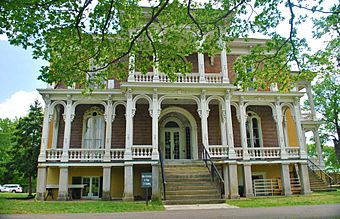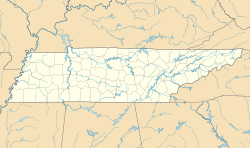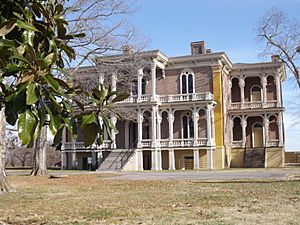Clover Bottom Mansion facts for kids
|
Clover Bottom Farm
|
|
 |
|
| Location | 2941 Lebanon Pike, Nashville, Tennessee, U.S. |
|---|---|
| Area | less than one acre |
| Built | 1858 |
| Architectural style | Italianate |
| NRHP reference No. | 75001747 (original) 100003900 (increase) |
Quick facts for kids Significant dates |
|
| Added to NRHP | April 3, 1975 |
| Boundary increase | May 7, 2019 |
The Clover Bottom Mansion is a historic house located in Nashville, Tennessee, United States. It has a long and interesting history. For 30 years, it has been the home of the Tennessee Historical Commission. This group works to protect and preserve important historical places in Tennessee.
Contents
The Story of Clover Bottom Mansion
Early Years and Construction
The land where Clover Bottom Mansion stands was first claimed in 1780 by John Donelson. He left his home after an attack. The mansion itself was built in 1859. It was the main building of the large 1,500-acre Clover Bottom Plantation.
Before this mansion, a different house stood here. It was built in 1853 in the Greek Revival style. Sadly, that house was destroyed by fire on February 7, 1859. The new mansion was built for Dr. James and Mary Ann Saunders Hoggatt. It was located near Nashville's first horse racing track. In 1860, many enslaved people lived and worked on the property.
The mansion was built in the Italianate style. This style often features tall windows, wide eaves, and decorative brackets. It looks very similar to another nearby house called Two Rivers Mansion. This suggests the same builder or architect might have worked on both. Inside, the home had beautiful French wallpaper and a painted ceiling in the parlor.
Life During the Civil War
During the American Civil War, an enslaved boy named John McCline lived at Clover Bottom Plantation. He escaped from the property in 1862. He then became a drover, helping to move animals for the Union Army. McCline later wrote a book about his life called "Slavery in the Clover Bottoms." This book gives a rare look into the life of an enslaved person in Davidson County during the Civil War. In 2015, a special marker was placed on the property to tell McCline's story.
Dr. Hoggatt passed away in 1863. During the Civil War, soldiers from both the Union and Confederate armies stayed at the house at different times.
Connections to Important People
Clover Bottom Mansion has ties to two members of Congress. One was Meredith P. Gentry, who was Dr. Hoggatt's brother-in-law. Mr. Gentry was a Congressman for both the U.S. and the Confederacy. After his first wife died, his daughters lived with the Hoggatts. Mr. Gentry later lost his money by supporting the Confederacy. He moved into Clover Bottom and passed away there in 1866.
In 1886, Mrs. Hoggatt sold the property to a relative named Andrew Price. Mr. Price was a Congressman from Louisiana who had family roots in Tennessee. He cared deeply about history. He restored the home and added several large outbuildings. He also raised thoroughbred horses on the property.
Later Owners and Restoration Efforts
In 1918, A.F. Stanford bought the house. His second wife, Merle Hutcheson Stanford Davis, moved there in 1927. She owned it until she sold it to the state of Tennessee in 1948. Mrs. Davis lived to be 104 years old. She visited her old home just a few months before she passed away in 2011.
After the state bought the house, it was used for different purposes. For a short time, it was a state trooper outpost. Later, it became housing for teachers at the Tennessee School for the Blind. Around 1980, the house was left empty. It was neglected for about ten years.
Then, a group led by Edward Nave and others from the Association for the Preservation of Tennessee Antiquities worked to save it. They convinced the State to restore the mansion. Since October 1994, it has been the home of the Tennessee Historical Commission.
The property also has several other important historic buildings. These include two former slave cabins from around 1858. They are among the few remaining slave dwellings in Davidson County. There is also a carriage house from the 1850s. The horse barn, built around the 1890s, is one of the best 19th-century barns in the area.
In 2015–2016, the Tennessee Historical Commission helped restore these historic outbuildings. Signs were added to explain their history. Over 150 native trees were planted, and a walking trail was created. The grounds are open to the public during daylight hours. As of October 2024, tours of the office are not available.
Architectural Style and Recognition
Clover Bottom Mansion was recognized for its historical importance on April 3, 1975. It was listed on the National Register of Historic Places. This is a list of places in the United States that are important to history.
In 2019, the listing was updated by the Tennessee Historical Commission. The boundaries of the property were made larger to include the outbuildings. At that time, its name was changed from Clover Bottom Mansion to Clover Bottom Farm.




